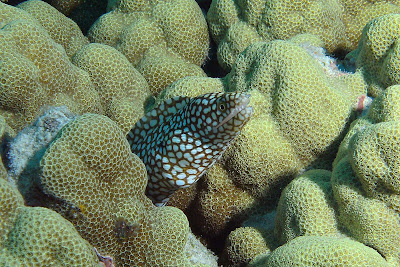Even before I got to the bay this morning I could see the Humpback Whales spouting from my Jeep as I drove down Hale O Keawe Road. Conditions were good with clear skies and low surf. When I entered the water, I could see that even though visibility was fair, there was a lot of floating particulate matter in the water.
Often, I end my posts with a sunset shot. For a change of pace, I'm starting today's post with a photo of the sun rising over Mauna Loa. I took this from the water's surface just before I started my first dive. Mauna Loa is a massive mountain but it has such a gradual slope to it that it's hard to tell it's a mountain. The name Mauna Loa literally means "long mountain".
Photo Copyright 2010 by Barry Fackler
I dropped down deep to start the dive and checked in on the little colony of Longfin Anthias. All seemed well with them and the male was standing guard over his coral head as usual.
Photo Copyright 2010 by Barry Fackler
Coming up the drop-off, this Eyestripe Surgeonfish passed right in front of me. It's a really attractive fish with beautiful colors and an ornately patterned tail fin.
Photo Copyright 2010 by Barry Fackler
This Potter's Angelfish is a common reef resident, but one that is very difficult for me to photograph. As soon as I point the camera towards one, it dives into the coral and stays there. I got a little lucky with this one.
Photo Copyright 2010 by Barry Fackler
Cleaning stations were really busy this morning. Here, a Manybar Goatfish gets worked over by a Hawaiian Cleaner Wrasse.
Photos Copyright 2010 by Barry Fackler
Coming back toward the Two-Step, I saw 3 or 4 Honu getting cleaned or swimming up to the surface for a breath of air.
Photo Copyright 2010 by Barry Fackler
As I was busying myself photographing the turtles, I sensed a presence above me. I looked up to see this Bottlenose Dolphin swimming overhead. I was amazed as I was in only 11 feet of water. This is a big dolphin, reaching about 10 to 12 feet long. Several years ago I had swum with a pair of Bottlenoses here in Honaunau Bay but they stayed in the deeper water beyond the drop-off.Bottlenose Dolphins have a uniform gray color to their backs and flanks as opposed to the three-tone color scheme of Spinner Dolphins. They also have stubby noses compared to the long, narrow snouts of Spinners. Bottlenose Dolphins also have a strongly backswept dorsal fin as opposed to the more vertical dorsal fin of the Spinner.
Photos Copyright 2010 by Barry fackler
Unfortunately, I was low on air when the lone dolphin made its appearance. I followed it for a while, watching it turn over rocks and coral rubble with its snout. Every once in a while it would rub its sides in the sand. These are all behaviors not often seen with Spinner Dolphins. Bottlenoses are usually social creatures traveling in small groups called pods. When one is found alone it is often because it is unhealthy or disoriented. This individual seemed quite healthy in appearance. I wondered if it was actually as lonely as it seemed. As I was low on air, I surfaced, but I hung out over the dolphin which was now in deeper water. I watched it as it casually browsed around the ocean floor, literally poking its nose in the nooks and crannies of the reef.
During my surface interval, I watched the dolphin surface and spout as it cruised around just off the reef. When I began my second dive, I looked around for the dolphin but it seemed to have disappeared. I turned my attention back to the reef where I made a couple more interesting discoveries.
Photo Copyright 2010 by Barry Fackler
Crawling blindly on a large rock, this sea cucumber looked somewhat hideous as it swept its oral tentacles about in search of organic detritus to consume. Most sea cucumbers move so slowly they appear inanimate, but this one was quite lively.
Photo Copyright 2010 by Barry Fackler
Tucked face down into the coral, this juvenile Commerson's Frogfish does it's best to be inconspicuous. As it matures it will lose its bright yellow coloration and will blend into the reef so well as to be almost invisible.
Photos Copyright 2010 by Barry Fackler
The high point of my second dive was finding this huge Partridge Tun. I had only seen one of these snails before, years ago when a dive guide found one. Betty and I often find fragments of the shells which are as thin as potato chips and easily allow light to pass through them. It is very uncommon for us to find an empty shell intact. Even this living example had some damage to the shell around the aperature. The foot of the animal appears far too large to retract into the shell. These snails are usually nocturnal, so to find one in the daytime was really great.
Photo Copyright 2010 by Barry Fackler
Low on air and coming back to the Two-Step, the ocean had one more treat for me. Around 50 Spinner Dolphins cruised by just beyond the drop-off. I had enough time to snap a couple pictures before surfacing.As I was off-gassing before heading uphill, I watched the whales surface and spout offshore. No breaches today. I've formed this theory that it's a group of 2 or 3 females hanging out there and one of them is getting ready to give birth. I think they're females because I don't hear singing when I'm underwater. Males sing to attract mates, females don't. For three weeks now they've been staying off the south point of the bay as if waiting for something to happen. I'll wait and see what develops.




























+copy+2.jpg)

























